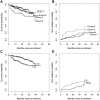Correlation between NIH composite skin score, patient-reported skin score, and outcome: results from the Chronic GVHD Consortium
- PMID: 22773386
- PMCID: PMC3460679
- DOI: 10.1182/blood-2012-04-424135
Correlation between NIH composite skin score, patient-reported skin score, and outcome: results from the Chronic GVHD Consortium
Abstract
There are no validated criteria to measure skin response in chronic GVHD. In a prospectively assembled, multicenter cohort of patients with chronic GVHD (N = 458), we looked for correlation of change in several different scales recommended by the National Institutes of Health (NIH) Consensus with clinician and patient perception of change and overall survival. Of the clinician scales, the NIH composite 0-3 skin score was the only one that correlated with both clinician and patient perception of improvement or worsening. Of the patient-reported scales, the skin subscale of the Lee Symptom Scale was the only one that correlated with both clinician and patient perception of improvement or worsening. At study entry, NIH skin score 3 and Lee skin symptom score > 15 were both associated with worse overall survival. Worsening of NIH skin score at 6 months was associated with worse overall survival. Improvement in the Lee skin symptom score at 6 months was associated with improved overall survival. Our findings support the use of the NIH composite 0-3 skin score and the Lee skin symptom score as simple and sensitive measures to evaluate skin involvement in clinical trials as well as in the clinical monitoring of patients with cutaneous chronic GVHD.
Figures


Comment in
-
cGVHD of skin: simple tools, great advances.Blood. 2012 Sep 27;120(13):2537-8. doi: 10.1182/blood-2012-07-442723. Blood. 2012. PMID: 23019199 No abstract available.
References
-
- Lee SJ, Klein JP, Barrett AJ, et al. Severity of chronic graft-versus-host disease: association with treatment-related mortality and relapse. Blood. 2002;100(2):406–414. - PubMed
-
- Chalandon Y, Passweg JR, Schmid C, et al. Outcome of patients developing GVHD after DLI given to treat CML relapse: a study by the Chronic Leukemia Working Party of the EBMT. Bone Marrow Transplant. 2010;45(3):558–564. - PubMed
-
- Johnston LJ, Brown J, Shizuru JA, et al. Rapamycin (sirolimus) for treatment of chronic graft-versus-host disease. Biol Blood Marrow Transplant. 2005;11(1):47–55. - PubMed
Publication types
MeSH terms
Grants and funding
LinkOut - more resources
Full Text Sources
Medical

